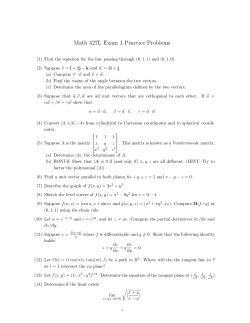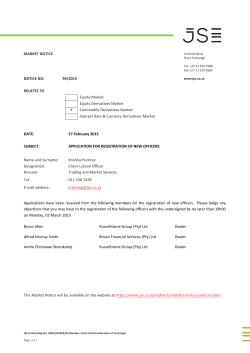
Here are the WebAssign problems.
Homework #8 (7092647)
Current Score:
Due:
Wed Mar 25 2015 11:59 PM EDT
1 2 3 4 5 6 7 8 9 10 11 12 13 14 15 16 17 18 19
0/12 0/1 0/8 0/1 0/2 0/8 0/2 0/3 0/3 0/2 0/4 0/8 0/1 0/6 0/1 0/2 0/2 0/3 0/6
Question
Points
1.
0/75
Total
0/75
0/12 points
SCalcET7 14.2.013.MI.SA. [3159505]
-
This question has several parts that must be completed sequentially. If you skip a part of the question, you will not receive
any points for the skipped part, and you will not be able to come back to the skipped part.
Tutorial Exercise
Find the limit, if it exists.
2.
0/1 points
SCalcET7 14.2.038. [2004958]
Determine the set of points at which the function is continuous.
{(x, y) | (x, y) ≠ (0, 0)}
{(x, y) | x
and y ≠ 0}
{(x, y) | x > 0 and y > 0}
{(x, y) | x · y ≠ 0}
{(x, y) | x
and y
}
-
3.
0/8 points
SCalcET7 14.2.AE.003. [2005157]
Video Example
EXAMPLE 3
SOLUTION
If f(x, y) =
6xy2
7x2 + y4
, does
lim
(x, y) → (0, 0)
-
f(x, y) exist?
Let's try to save some time by letting (x, y) → (0, 0) along
any nonvertical line through the origin. Then y = mx, where m is the
slope, and
f(x, y) = f(x, mx) =
2
6x
7x2 + (mx)4
=
=
7x2 + m4x4
So f(x, y) →
.
7 + m4x2
as (x, y) → (0, 0) along y = mx.
Thus f has the same limiting value along every nonvertical line through the
origin. But that does not show that the given limit is 0, for if we now let
(x, y) → (0, 0) along the parabola x = y2, we have
f(x, y) = f(y2, y)
· y2
=
7(y2)2 + y4
=
8y4
=
So f(x, y) →
.
as (x, y) → (0, 0) along x = y2.
Since different paths lead to different limiting values, the given limit does
not exist.
4.
0/1 points
SCalcET7 14.2.018. [1887003]
Find the limit, if it exists. (If an answer does not exist, enter DNE.)
lim
xy4
(x, y) → (0, 0) x2 + y8
-
5.
0/2 points
SCalcET7 14.3.006. [1888966]
-
SCalcET7 14.3.015.MI.SA. [1724065]
-
Determine the signs of the partial derivatives for the function f whose graph is shown below.
(a)
fx(−x0, y0)
positive
negative
(b)
fy(−x0, y0)
positive
negative
6.
0/8 points
This question has several parts that must be completed sequentially. If you skip a part of the question, you will not receive
any points for the skipped part, and you will not be able to come back to the skipped part.
Tutorial Exercise
Find the first partial derivatives of the function.
f(x, y) = y9 − 8xy
7.
0/2 points
SCalcET7 14.3.019. [1898048]
-
SCalcET7 14.3.031. [1898101]
-
SCalcET7 14.3.034. [1898116]
-
SCalcET7 14.3.047. [1857244]
-
Find the first partial derivatives of the function.
z = (9x + 2y)6
∂z
=
∂x
∂z
=
∂y
8.
0/3 points
Find the first partial derivatives of the function.
f(x, y, z) = xz − 3x5y7z5
fx(x, y, z) =
fy(x, y, z) =
fz(x, y, z) =
9.
0/3 points
Find the first partial derivatives of the function.
w = 3zexyz
∂w =
∂x
∂w =
∂y
∂w =
∂z
10.
0/2 points
Use implicit differentiation to find ∂z/∂x and ∂z/∂y.
x2 + 4y2 + 9z2 = 9
∂z
=
∂x
∂z
=
∂y
11.
0/4 points
SCalcET7 14.3.053. [1905186]
-
SCalcET7 14.4.002.MI.SA. [1723990]
-
Find all the second partial derivatives.
f(x, y) = x8y6 + 6x6y
fxx(x, y) =
fxy(x, y) =
fyx(x, y) =
fyy(x, y) =
12.
0/8 points
This question has several parts that must be completed sequentially. If you skip a part of the question, you will not receive
any points for the skipped part, and you will not be able to come back to the skipped part.
Tutorial Exercise
Find an equation of the tangent plane to the given surface at the specified point.
z = 3(x - 1)2 + 2(y + 3)2 + 7, (4, 3, 106)
13.
0/1 points
SCalcET7 14.4.006. [1853508]
-
SCalcET7 14.4.011. [1853638]
-
Find an equation of the tangent plane to the given surface at the specified point.
z = ln(x − 5y),
14.
(11, 2, 0)
0/6 points
Explain why the function is differentiable at the given point.
f(x, y) = 9 + x ln(xy − 7),
(2, 4)
The partial derivatives are fx(x, y) =
fy(2, 4) =
. Both fx and fy are continuous functions for xy >
Find the linearization L(x, y) of f(x, y) at (2, 4).
L(x, y) =
and fy(x, y) =
, so fx(2, 4) =
and
and f is differentiable at (2, 4).
15.
0/1 points
SCalcET7 14.5.013. [2476110]
-
SCalcET7 14.5.014. [1905108]
-
SCalcET7 14.5.015. [1905154]
-
If z = f(x, y), where f is differentiable, and
x
g(5)
g' (5)
fx(3, 0)
= g(t)
= 3
= −9
y
h(5)
h' (5)
fy(3, 0)
= −2
= h(t)
= 0
= 9
= 7
find dz/dt when t = 5.
dz
=
dt
16.
0/2 points
Let W(s, t) = F(u(s, t), v(s, t)), where F, u, and v are differentiable, and the following applies.
u(3, −8) = 5
us(3, −8) = −4
ut(3, −8) = 2
Fu(5, 4) = 9
v(3, −8) = 4
vs(3, −8) = 1
vt(3, −8) = −7
Fv(5, 4) = 0
Find Ws(3, −8) and Wt(3, −8).
Ws(3, −8) =
Wt(3, −8) =
17.
0/2 points
Suppose f is a differentiable function of x and y, and g(u, v) = f(eu + sin v, eu + cos v). Use the table of values to calculate
gu(0, 0) and gv(0, 0).
f
g
fx
fy
(0, 0)
0
3
1
2
(1, 2)
3
0
5
4
gu(0, 0) =
gv(0, 0) =
18.
0/3 points
SCalcET7 14.5.021. [1853589]
Use the Chain Rule to find the indicated partial derivatives.
z = x4 + x2y,
∂z , ∂z , ∂z
∂s ∂t ∂u
∂z
=
∂s
∂z
=
∂t
∂z
=
∂u
x = s + 2t − u,
y = stu2;
when s = 5, t = 2, u = 1
-
19.
0/6 points
SCalcET7 14.5.038.MI.SA. [1724146]
This question has several parts that must be completed sequentially. If you skip a part of the question, you will not receive
any points for the skipped part, and you will not be able to come back to the skipped part.
Tutorial Exercise
The radius of a right circular cone is increasing at a rate of 1.7 in/s while its height is decreasing at a rate of 2.4
in/s. At what rate is the volume of the cone changing when the radius is 165 in. and the height is 173 in.?
Assignment Details
-
© Copyright 2025











